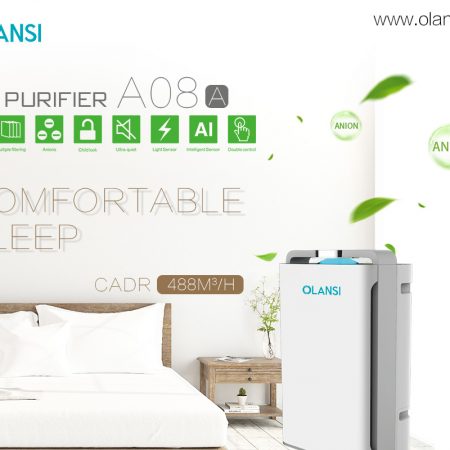Olansi Air Purifier teach you how to choose an Air Purifier
Clearly, the fact that you found this webpage means that you already know how important it is to have an air purifier in your home or business. So, we don’t have to waste your time trying to convince you to get one.
However, you’re probably still wondering how to choose an oem air purifier that’s right for you.
With so many different brands and types of air purifiers, it may seem overwhelming at first for how to choose the best one that fits your needs. But, don’t worry because we are here to help by sharing everything you need to know in order to get the best air purifier for your needs.
Below, you’ll find this free guide pided into five parts:
1.What Do you Want the China Air Purifier to Do
2.How to Choose the Right Technology and Filter Type
3.Determining How Powerful a Unit You Need
4.Understanding Clean Air Delivery Rate (CADR) Rating
5.Cost of Ownership and Maintenance
As you read through each section below, we suggest that you take notes on a sheet of paper about the various features that are important to you. By doing so, you will know exactly which air purifier you will need by the time you are done reading and be able to choose the best air purifier for your needs.
Let’s get started!
What Do You Want the Air Purifier to Do
Its very important that you start the process of choosing and air purifier by asking yourself this question, “What do you want the air purifier to do ” With so many different types of air purifiers on the market today, answering this question will help narrow down your options considerably and make the decision much easier.
As you’ll learn in the next section below, there are different filter types for home air purifiers. Each filter type is designed specifically to purify the air of certain toxins and pollutants.
So, what do you really want the purifier to do Do you want it to help reduce your allergies caused by microscopic particles Are you suffering from pet dander or hair Do you want to rid your house of smoke Would you like to eliminate airborne bacteria and harmful viruses floating around in your house Are you looking to eliminate odors and smells in your home Do you just want to improve the overall health of yourself and/or your family
How to Choose the Right Technology and Filter Type
Now that you know what you want the air purifier to do, the next step is to determine which is the proper filtering technology that will achieve your desired outcome.
As we mentioned before, each type of purification system is better at filtering certain contaminants from the air than the rest.
Now, instead of boring you with all of the technicalities about how the underlying technology works for each filtering system works, we’ll instead make this step easy for you to understand. We’ll skip the technobable and share with you what really matters, the pros and cons of each type.
True HEPA Filter
This is a highly effective, physical type of filter that you are most likely used to seeing that cleans the air.
Don’t confuse the term “true HEPA” with “HEPA-type” when considering a hepa air purifier. They are drastically different. A true HEPA filter air purifier has been certified to remove 99.7% of particles as small as 0.3 microns. A HEPA-type filter may only remove particles as small as 2-3 microns. For comparison, a human hair is 2 microns in size.
Pros:
Removes pollen, mold spores and
Particles not released back into the air
Cons:
Does not remove odors, gas or smoke
Not effective in trapping particles smaller than .3 microns (viruses and bacteria)
Ionic Air Purifier (Also known as an Ionizer)
This technology does not have an actual filter, but instead sends out negatively charged particles into the air that bond to bad particles. This combination of ions then becomes too heavy to remain in the air and fall to the floor.
Pros:
Removes very small particles, 0.01 microns
Sterilizes bacteria and viruses
Cons:
Does not trap particles. Just pulls them out of the air, but not from the room. Particles may float back into the air. Must vacuum them up to eliminate them completely.
Does not remove odors
Ultra Violet (UV) Light
This system use electromagnetic radiation to break apart the DNA of germs and viruses. It is best combined with other filter types.
Pros:
Kills most bacteria and viruses
Helps prevent illness and disease
Cons:
Does not remove most allergens or dust in the air
Does not remove smoke, fumes or gases
Carbon Filter
These filters have small absorbent pores that cause contaminants to bond with the carbon and become trapped. These types of purifiers are excellent at removing odors from pets, chemicals and pets. Because of their limited pollutant removal, most often you’ll find this type of filter combined as a pre-filter with another type of filter.
Pros:
Most absorbent
Eliminates chemical fumes, gases, smoke and odors
Does not release contaminants back into the air
Cons:
Does not remove dust and other allergens
Does not remove micro-organisms, such as viruses and bacteria
Determining How Powerful a Unit You Need
When you’re deciding on how to choose an air purifier for your home or business, the size of the room is very important for which device you get. You don’t want to waste money on a unit that is more powerful than the room is intended for and vice verus.
Not all air purifiers are designed to purify the same amount of space. For each device you’ll see a figure listed for “Average Coverage” or “Room Size” in square feet. For example, one device may only be able to purify a maximum space of 150 square feet, while another unit can purify up to 300 square feet.
So, find out what the square footage is for the room(s) in which you want to use an air purifier, and let that be your guide. If you don’t know how to calculate the square footage for a room, here is an easy to use online square footage calculator.
Understanding Clean Air Delivery Rate (CADR) Rating
The CADR rating tells you how well the air is purified by the device. Its important because it tells you how effective the air purifier is against removing three particular pollutants: dust, pollen and tobacco smoke. Just remember, the higher the numbers, the faster the unit filters the air.
Cost of Ownership and Maintenance
Something many people don’t take into consideration when deciding how to choose an air purifier for their home or business is the actual true cost of ownership. Depending on the technology and filter type used, some devices have higher maintenance costs than other units and may use up more energy.
When choosing an air purifier that uses a true HEPA or carbon filter, you must factor in the cost of replacing the filters throughout the year. Some units may require a replacement every six months or sooner and these costs can start to add up. When deciding on the right air purifier for your needs, research the price of replacement filters in order to see if the maintenance can fit within your budget.
For your healthy,we sincerely suggest our Olansi air purifier to you,it can improve your indoor air quality.Olansi air purifiercontain OEM Air purifier,China Air purifier,Home air purifier,hepa air purifier and so on.


